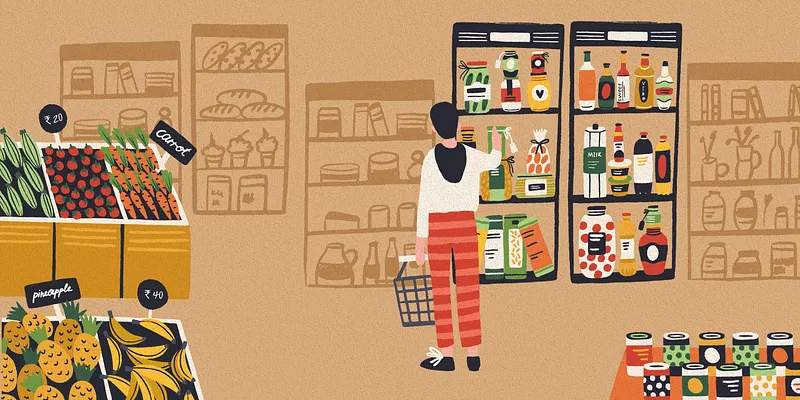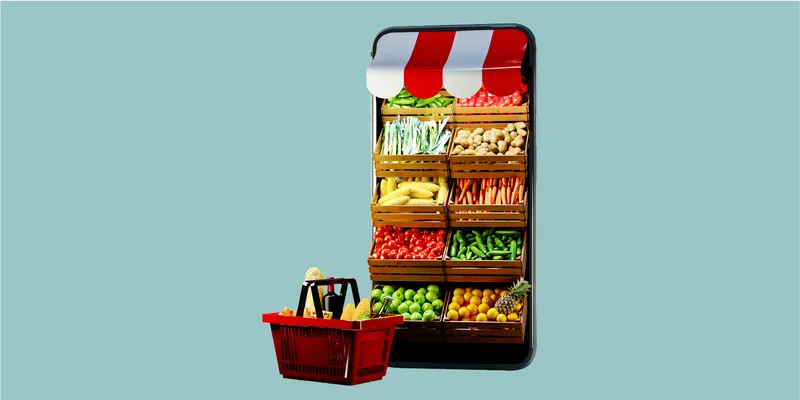[Product Roadmap] How Qwipo uses technology to help over 7,000 retailers connect with prime vendors
In this week’s Product Roadmap, we feature Qwipo, a B2B technology-enabled marketplace solving the sourcing and logistics needs of business retailers. It connects kiranas, hotels, cafes, and restaurants with prime vendors like distributors, wholesalers, and white label manufacturers via technology.
Hailing from business families, Siva Morisetti and Siva Mamidi had seen the challenges of running businesses. They always felt there was a need for tech to simplify several of the challenges SMEs faced. The duo, who met four years ago at a common’s friend’s house in the US, often discussed the growing Indian economy and the adoption of ecommerce by businesses.
“By the time we met, Siva Mamidi had already incorporated a few months back and just got bootstrapped on a B2C business (connecting individual consumers to local retailers). He needed help with marketing, sales, product management, and finance verticals and was looking for a co-founder. Both of us immediately connected on goals, vision, and the mission , and joined hands,” says Siva Morisetti.
Today, Qwipo connects business retailers (kiranas, hotels, restaurants, cafes) with prime vendors (distributors, wholesalers, white label manufacturers)) using technology. Its mobile and cloud technology lets:
- Prime vendors post their products using Qwipo Vendor Mobile App
- Business Retailers place product orders using Qwipo Retailer Mobile app
In marketplace mode ( retailers are connected directly to the vendors), Qwipo operates on a decentralised distribution model where warehousing of the products does not happen. Products are picked from the prime vendors by the Qwipo Operations team and directly delivered to retailers.
Cloud Server Software works in the background and optimises (aggregation of orders to the vendors, assigning right sized trucks for the right weight, etc) delivery to retail stores from prime vendors and guides the Qwipo delivery executives to deliver products to retailers who have placed the orders.

Survive with quick commerce
Morisetti explains the vision was to help local retailers sustain and compete against the new upcoming central warehouse models, which “we perceived are not economically viable models”. For example, buying a box of pens of a certain brand or a charging cable for a phone from an online ecommerce company would involve a shipment from a warehouse that is too far away from the consumer and involve a lot of shipment costs as compared to delivery of the same product from a local vetted retailer at a minimal cost.
“For many such products, shipping costs were a major component of the overall cost. After running Qwipo B2C business for some time, we noticed major challenges integrating local retailers into the technology platform we built (primarily around price changes on a daily basis and inventory management), and decided to pause B2C operations,” Morisetti says.
However, the retailers weren’t ready, and the founders saw another need. The team quickly founded the B2B business model and SMEs started repurposing the technology platform to B2B customers.
“On the B2B front, we noticed HORECA (Hotels, Restaurants and Cafes) customers were struggling to procure their daily needs (vegetables and groceries) and ran into challenges arranging logistics to get the products delivered to their businesses. They were plagued with dealing with middlemen, talking to various suppliers offline (phone and personal visits) consuming a lot of their valuable time, conducting efficient logistics etc. We saw a huge opportunity in this sector. Qwipo now serves kirana stores as well; they constitute a major customer base,” Morisetti explains.
The startup has been consistently growing quarter over quarter and adding vendors, business retailers, and locations. It is at present operating in two Indian states, covering over 40+ geographical locations, and planning to launch in another state soon.
“We have over 9,000+ business retailers transacting on the platform. We have more than 200+ vendors on the platform, three lakh+ orders delivered, 15,000+ tons material delivered so far since inception,” he says.
The focus on the HORECA segment in the first year of the business helped the team see the potential in the grocery, staples, and FMCG sectors.

Image credit: Yash, YS Design
Understanding the market challenges
Qwipo started off with an inventory model - they directly purchased products, kept inventory in their warehouses, and delivered to customers for orders received. Customers placed orders from the Qwipo APP installed on their smartphones.
“We saw some of the challenges operating in the inventory model - scale, wastage, pilferage, warehouse costs, CAPEX costs, price fluctuations due to sudden government regulations. We then decided to operate in a marketplace model, connecting retailers to vetted vendors and avoiding the need to warehouse the inventory. We essentially leverage vendors’ existing infrastructure and offer them technological benefits to serve business retailers,” Morisetti says.
The first product built was simple, to serve the core needs of the businesses. It contained minimal (essential) SKUs, the ability to pick a particular delivery slot, and the ability to change the order (quantities or SKUs) within a certain time after it was placed.
Building the newer model
“We could reach team members who were part of that and paid them hourly. Due to the strong rapport with the team members, we could easily get them onboarded to work on a part-time basis. The CI/CD platform was repurposed. For the cloud, we signed up with Azure as it gave heavy discounts being a startup,” Morisetti says. It took two months to build the prototype.
The current B2B model (after the pivot from the B2C model very early on after the company incorporation) has been running for the past three years. The first product (serving vegetables and perishables in inventory mode to the HORECA customers ) was very convenient to the users because of these aspects:
- Delivery slot timings: “We kept the delivery slot open till 10pm the previous night. This enabled the team to attract more customers as a lot of retailers would get time to order late in the night after the closure of their daily business operations.”
- Accept quantities even when out of inventory: “When orders get placed, the order quantities typically gets checked against the inventory held and rejected if there is no inventory. For the first six months, we accepted orders even if we ran out of inventory. We enabled our team to procure in the morning (4-5am) and have delivered in the morning before 9am.”
- Accept returns with replacement: “At the time of delivery, if a customer returned any item due to incorrect order from his side or for any quality reasons, we accepted and worked on the replacement within two hours.”
- Product/SKUs selection: “We earned the name of availability of all SKUs on our platform. As it would not be convenient for customers to place partial orders on an ecommerce platform and buy rest from offline sources, we made sure of availability of all SKUs despite difficulty in sourcing all every single day,” Morisetti says.
MVP and the learnings
Morisetti explains a few key factors helped the team with the scale during the MVP days.
- Feature prioritisation: The team made sure whatever enhancements they were building are absolutely needed by the customers. The team made sure the customers' personas were clearly understood.
- Quality and customer experience: Ecommerce platforms involve numbers and real money. “We deeply understood that. We made sure testing was done thoroughly, avoiding crashes and incorrect data,” Morisetti says.
- Alerting sales, operations, and customer teams: All these three teams, who are customer facing, were made to understand every new feature that was built into the technology so that they could explain to the customers well. “Even today, we have a demo day to these internal teams before we release a new version of our mobile and web applications.”
- Consistent Marketing Messaging
Morisetti explains they realised that the customers did not need all the bells and whistles; they needed core problems to be solved.
For instance, providing a gateway to do digital transactions is not an absolute must for everyone; they could pay cash as well. On the other hand, having a delivery slot open late in the night was a big benefit.
“Core problems were procurement and logistics. We focused mainly on these two aspects. We found customers are more interested in focusing on their business and have non-core aspects (procurement and logistics primarily) be taken care of by someone else. Now, when they run into issues, they want issues to be taken care of by the platform that provided the service rather than them spending cycles. Hence, we gave utmost priority to addressing every single issue that came to our customer service team (or complaints received by our delivery partners from sales executives who directly get to hear from customers during interactions),” Morisetti says.
Apart from building the technology platform, which is both mobile and web-based, the other major challenge the team faced during development was that of building technology applications for internal teams to help carry out daily operations.
“As we added thousands of customers, this has been extremely important. Tracking manually was no option. Meeting the absolute needs of different departments and delivering on time was a challenge. Prioritisation has really worked for us. And also setting the expectations on when and at what time it would be delivered really helped,” Morisetti says.

Newer innovations
Some of the key innovative technological solutions over time include:
Route planner: A route planner for logistics would be helpful to people looking to transport goods or materials around the globe. Route planners can be customised for certain needs such as destination, type of product being transported, date of travel, etc. It is important to plan well enough in advance because the only way to ensure that all steps are taken to make the delivery or pickup happen in a timely manner is when there is plenty of time to do so.
This can be accomplished through automation - that is creating routes that are well thought out (considering weight, number of orders in a particular area, vendor location, customer location etc) and creating an order of operations. The route planner will help keep track of the trip so that there are no delays/problems with deliveries.
Digital sales aid app: This application provides assistance with sales and marketing. The digital sales aid mobile app helps sales team visualise and work through their sales achievements. It allows the team to get on the field, provides an efficient route for regular visits to the customers, offers customer insights and trends, and generates leads without relying on office infrastructure. It also provides an efficient way for sales reps to create qualified leads.
In the near future, the Qwipo team is looking to deploy new solutions. These include:
a. Price Predictions: For the vendors (suppliers), applying artificial intelligence on inventory and prices can further ease their day-to-day sales. “We are working on utilisation of AI algorithms to aid in predicting price fluctuations for the stock in use and effective usage of inventory. As an example, a particular SKU sitting in inventory in large quantities while the market price has been continuously going down should warn and alert the vendor to reduce the price to help on faster movement (sales) of the product,” Morisetti says.
b. Search Engine: An AI-powered search engine will help customers find desired products faster by learning more about their habits and preferences.
Edited by Teja Lele


![[Product Roadmap] How Qwipo uses technology to help over 7,000 retailers connect with prime vendors](https://images.yourstory.com/cs/2/a9efa9c02dd911e9adc52d913c55075e/ProductRoadmap-1643114808851.jpeg?mode=crop&crop=faces&ar=2%3A1&format=auto&w=1920&q=75)
![[Product Roadmap] With a presence in 200 cities, how Nivesh is using tech to win tier II and III India](https://images.yourstory.com/cs/2/a9efa9c02dd911e9adc52d913c55075e/ProductRoadmap-1641307360381.jpg?fm=png&auto=format&h=100&w=100&crop=entropy&fit=crop)
![[Product Roadmap] How focus on technology helped Namaste Credit serve over 25,000 SMEs in 6 years](https://images.yourstory.com/cs/2/a9efa9c02dd911e9adc52d913c55075e/GauravAnandNamasteCredit-1641904739862.jpeg?fm=png&auto=format&h=100&w=100&crop=entropy&fit=crop)




